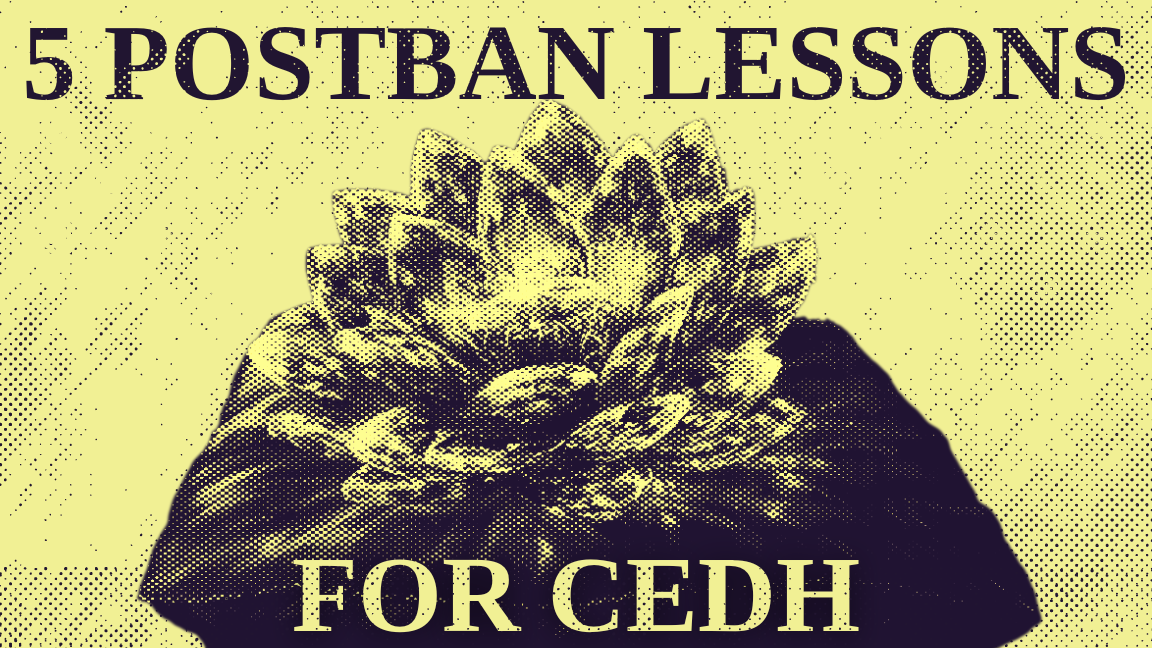Five Post-Ban cEDH Lessons

This past weekend, I participated in the SCG Con DC cEDH 5k tournament. Over a hundred players from across the United States descended on the Dulles Expo Center in what was one of the first large cEDH tournaments after the format was rocked by the recent bannings of Jeweled Lotus
Needless to say, the format is still settling into place after such a massive shakeup, but some lessons were immediately clear from the tournament. So, what can we learn?
Totally fair mana acceleration.
Lesson One: Games are more than one turn longer.
When the bans were first announced, most cEDH players I know immediately predicted that games would be at least one turn longer. The logic went that turn one became much more of a developement turn, as opposed to an action turn. Pre-bans, players could both deploy mana and use it in the same opening turn. This all came down to cards like Mana Crypt
Turn one Rhystic Study
After the bans, this is now far less frequent. The most common first turns at SCG Con DC were purely developmental, with players tossing around Sol Ring
On top of not being proactive on turn one, this also means that players aren't accumulating resources through turn-one engines nearly as frequently. Landing the likes of Pollywog Prodigy
Since these early-turn advances are much rarer now, the snowballing-value they accumulate is also delayed a turn, creating a real delay in their otherwise absurd effectiveness. Just think about The One Ring
Lesson Two: Interaction is more flexible - and expendable.
If Lesson One was all about Mana Crypt
The answers to these two questions reveal how Dockside Extortionist
The natural response from players was to wage counterwars over Dockside, but the problem was that very few such spells could actually answer Dockside's threat - Force of Will
The result of this limited toolkit of answers was that cEDH games would result in crux-points of interaction deployment. Players kept interaction tight, only deploying it when absolutely necessary, as tunnel-vision would set in around the question of "when is someone casting Dockside?" Without this omnipresent Goblin in the format, players are now inclined to deploy countermagic in a more relaxed fashion. Sure, there are creature combos still out and about, but there isn't the same boogieman haunting any-and-every cEDH table with red in the pod.
Lesson Three: Don't discount the "Jeweled Lotus" commanders.
Did I mention that Godo, Bandit Warlord
Jeweled Lotus
Decks like Urza, Lord High Artificer
Now, the upside to playing these decks - many of which are low-color lists that shy away from good-stuff piles in order to focus on high-synergy builds - just isn't as appealing anymore. That being said, after fighting against (and losing to) several of these commanders down at SCG Con DC, I can't say that they're all dead.
We've talked alot about the fast mana that has left cEDH recently, but it's equally important to remember just how much we still have. Chrome Mox
When you compare this against the pace of the rest of the format, things start to look a little better for our commander-dependent friends: everyone is slower now, so - in a weird, equalizing way - no one is.
Ultimately, I have a feeling that future tournaments will reveal that the loss of Jeweled Lotus
Lesson Four: RogSi is certainly still scary, but it isn't everything.
When I settled in to play at DC, I was expecting to see RogSi everywhere. The partner pair of Rograkh, Son of Rohgahh
In short, if everyone else was around a turn slower at minimum, RogSi was only slowed down half a turn. Or so I thought.
It is true that RogSi was hurt significantly less than many other decks in the format. It doesn't miss the banned cards as much as other decks, and that is reflected in terms of the pace at which it plays. The deck is still the very definition of turbo - aiming to win as early as turn one (and quite reliably at that).
The problem, however (as I mentioned earlier in Lesson Two) is that countermagic is a bit more flexible now, and every other deck in the format is sitting in to play a longer game. So, RogSi now finds itself fighting against a lot more interaction in the early game, effectively negating the disparity in speed which the bannings created. If the RogSi pilot in your pod can't win on turns one or two, then odds are it won't be winning that game at all.
Lesson Five: Green, especially Kinnan, is much better now.
Now on to the real winner from the bans: green. Care to take a guess as to what gets a lot better when it has an extra turn to untap? Mana dorks. Now add Gaea's Cradle
Part of green's biggest problem, pre-ban, was that the mana it produced was simply a turn too slow. cEDH was a game played in bursts, be it rituals or Dockside Extortionist
This brings me to Kinnan, Bonder Prodigy
Mana production is slower right now, unless you're Kinnan, that is. Doubling up on mana dork output is one of the best things to be doing in the format right now, and Kinnan does this consistently, resulting in game after game where the deck's pilots routinely have more mana than the rest of the pod combined.
From my early impressions in DC, I'd venture to say that Kinnan is probably one of the best targets for cards like Mockingbird
Wrap Up
It's going to be a bit before cEDH truly settles into the post-ban meta, but as I play more and more games, the more optimistic I become. I no longer fear the initially-expected tyranny of RogSi, nor am I mourning every four-drop commander that ran Jeweled Lotus